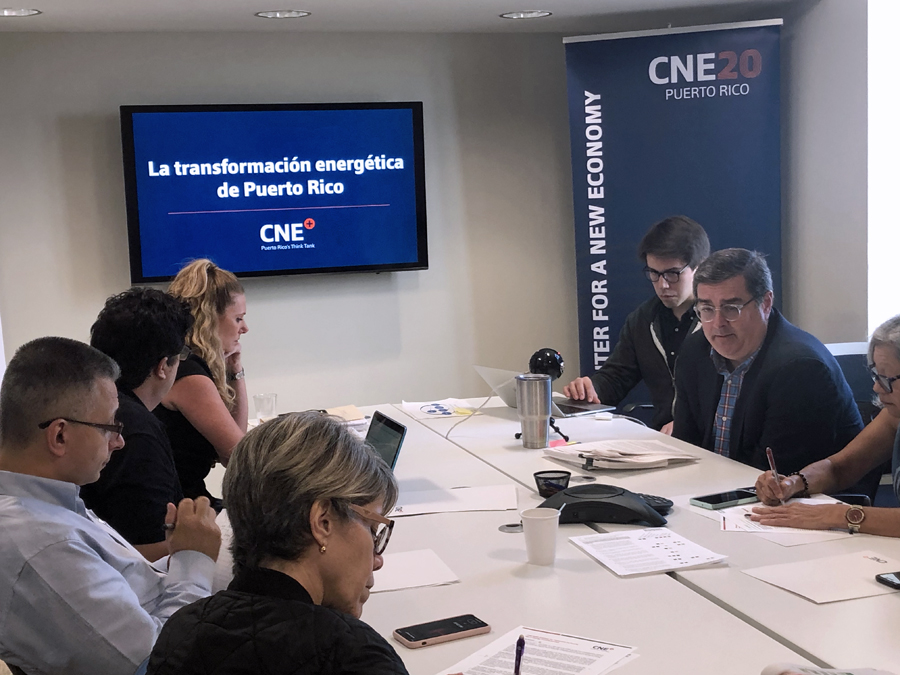CNE reviews ‘key events’ in the pipeline for P.R.’s energy policy

The Center for a New Economy recently hosted members of the media to provide context and information to journalists as they prepare to cover two key events for Puerto Rico’s energy policy.
First, the Puerto Rico Energy Bureau will hold a public hearing in February to discuss Puerto Rico Electric Power Authority’s (PREPA) Integrated Resource Plan (IRP), a 20-year proposal for modernizing the island’s energy system.
Second, Judge Laura Taylor Swain, who was appointed to oversee Puerto Rico’s bankruptcy process, will also hold a hearing early in the year to review oral arguments for and against PREPA’s Restructuring Support Agreement (RSA) with a group of its bondholders.
Sergio Marxuach, CNE Policy Director, emphasized that the proposed IRP and RSA will increase the cost of electricity on the island and disincentivize the generation of energy from renewable sources.
Given the current state of the energy grid, the delay in federal disaster recovery funds, population loss and the continued shrinking of Puerto Rico’s economy, the proposed changes would likely increase energy costs on the island by 20% or more in the next five fiscal years, according to CNE’s analysis.
The RSA would impose additional energy costs to pay bondholders, including a transition charge that penalizes the generation of renewable energy. The energy charges imposed by the agreement would apply to all consumers regardless of whether they generate their own electricity, unless they are completely and permanently disconnected from PREPA’s grid.
These conditions, said Marxuach, are meant to ensure that consumers don’t leave the grid, which would threaten PREPA’s capacity to pay back its debts.
“The charges proposed in the RSA will make Puerto Rico’s energy system less affordable and sustainable, in direct opposition to the goals and wishes of the vast majority of consumers and interest groups in Puerto Rico,” said Malu Blázquez, executive director of the CNE program ReImagina Puerto Rico.
‘Massive investments’ in infrastructure, with no repayment source
Marxuach and Blázquez also expressed concerns with PREPA’s IRP, saying the plan calls for “massive investments” in new natural gas infrastructure that would cost hundreds of millions of dollars, without establishing a clear way to pay for them.
The analysts highlighted that the proposed IRP goes against the recommendations of PREPA’s own consultants, who had suggested fewer natural gas investments and greater use of renewable resources.
PREPA’s recommended plan also fails to comply with the new energy public policy of the Puerto Rico government: a bill signed into law earlier in the year established a goal of 50% renewable energy generation by 2040 and 100% by 2050, an outcome impossible to achieve under PREPA’s proposed IRP and RSA, Marxuach and Blázquez said.
They added that the final IRP should serve as the master plan for the transformation of Puerto Rico’s electrical system in the next 20 years, and that major capital investments and generation privatization efforts should not occur until the IRP is approved.
While PREPA claims that natural gas infrastructure will lower energy costs, CNE’s analysts explained that such projections do not take into account the massive cost of building new infrastructure, which will most likely be passed on to energy consumers.
“PREPA and the Puerto Rican government insist on making decisions that will increase the cost of electricity, limit economic growth, increase unemployment and impose destabilizing costs on thousands of families,” said Marxuach. “The politicians and government officials currently in power will have to answer to the people of Puerto Rico for these actions.”
CNE has a long track record of research and analysis of Puerto Rico’s energy sector. Since 2005, the Center has repeatedly denounced PREPA’s monopolistic tendencies and unexplained increases in energy costs.
In 2013, CNE led a campaign calling for an explanation of the charges that the public utility adds to consumers’ energy bills, and in 2014 advocated for the creation of the Puerto Rico Energy Commission.
As an alternative to PREPA’s plans, Blázquez emphasized the need for an affordable, reliable and innovative energy infrastructure that reduces adverse impacts on human health and the environment.
She shared ReImagina Puerto Rico’s energy policy recommendations, derived from a series of focus group meetings with subject matter experts and the communities most affected by Hurricane María.
These include integrating microgrids, minigrids and renewable energy into the island’s energy grid to the greatest extent possible, and creating mechanisms for consumer input and participation in the development of resilient energy systems, specifically for vulnerable individuals and critical facilities.














